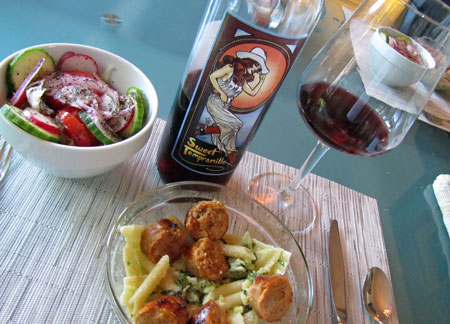VintageTexas Sunday ‘Cyclopedia of Wine: CapRock Sweet Tempranillo – An Old Technique with a Texas Twist
Natural wine aficionado, Alice Feiring, said, “First time I had a well-made wine from carbonic maceration…I was pretty charmed. The wine was, as they say, gulpable, vin de soif stuff [thirst-quenching wine]. There are times (and were times) when these mostly easy drinkers were just what I wanted to suck down, because they were so refreshing and surprising. Easy in wine is not so bad, not forever, but sometimes they are just sociable wines.”
But, what exactly is carbonic maceration…
Carbonic maceration is a winemaking technique, often associated with the French wine region of Beaujolais and their Gamay grape. Some attribute this method’s creation to ancient Roman winemakers that brought their skills to Gaul (in Latin: Gallia, a region of Western encompassing present day France).
The process is simple and involves the fermentation of whole grapes in a carbon dioxide rich environment (often produced by the initial fermentation). Carbonic maceration ferments most of the juice while it is still inside the grape. This process results in a wine is crisp and fruity with very low tannins, and it’s ready to drink young.
Fast forward to Texas and the grand vintage of 2010….
That was the year that new life (and money) was pumped into Lubbock’s CapRock Winery. Grapes were plentiful leading to an opportunity for CapRock Winery to make a bright, refreshing wine – Sweet Tempranillo (2010, Texas High Plains Appellation). While this name may be a slight misnomer (as the wine has only about 0.5% residual sugar), the wine is a true delight to drink, particularly in this year’s summertime heat.
CapRock Sweet Tempranillo was made using this ancient winemaking style of carbonic maceration, but in stainless steel tanks. The result is a fun wine, not exactly what you think of in the light of modern Spanish Tempranillos that are made in a bold, oak-aged style.
Sweet Tempranillo is more in the lesser-known (at least in the US) Spanish style, vino joven (young wine) or Sin Crianza. These are wines having very little, if any, oak aging, and meant to be consumed very young – often within a year of their release. It has dominant red fruit notes, crisp acidity and a refreshingly fruity, off-dry presence; best consumed slightly cool, as if a Beaujolais. I served it with spicy Italian sausage and cucumber-radish-tomato-onion salad. Give it a try!



Found you quite by accident via stumble upon, right in the middle of our Texas tour! What great reading tomorrow as I ride from Gruene to Corpus Christi! I’ll know EXACTLY what wine to choose! Nice to meet you!